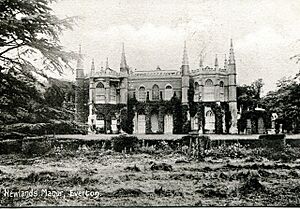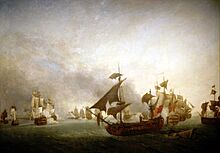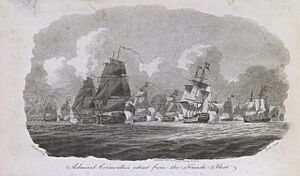William Cornwallis facts for kids
Quick facts for kids
The Honourable Sir
William Cornwallis
|
|
|---|---|
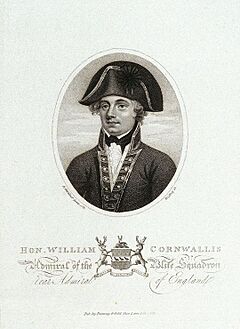
Admiral William Cornwallis after a Portrait by Daniel Gardner, Published in the Naval Chronicle
|
|
| Member of Parliament for Eye |
|
| In office 1801–1807 |
|
| In office 1790–1800 |
|
| In office 1782–1784 |
|
| In office 1768–1774 |
|
| Member of Parliament for Portsmouth |
|
| In office 1784–1790 |
|
| Personal details | |
| Born | 10 February 1744 |
| Died | 5 July 1819 (aged 75) |
| Relations | Charles Cornwallis, 1st Marquess Cornwallis, Charles Townshend, 2nd Viscount Townshend |
| Nicknames | "Blue Billy" "Coachee", "Billy go tight" and "Mr Whip" |
| Military service | |
| Allegiance | United Kingdom |
| Branch/service | Royal Navy |
| Years of service | 1755–1806 |
| Rank | Admiral |
| Commands | HMS Wasp HMS Swift HMS Prince Edward HMS Guadeloupe HMS Lion HMS Canada HMS Ganges HMY Charlotte HMS Robust HMS Crown East Indies Station Channel Fleet |
| Battles/wars | |
Admiral Sir William Cornwallis (born February 10, 1744 – died July 5, 1819) was a brave officer in the Royal Navy. He was the brother of Charles Cornwallis, 1st Marquess Cornwallis, who was a British commander during the American War of Independence.
William Cornwallis fought in many important battles. These included the siege of Louisbourg in 1758, when he was just 14 years old. He also took part in the Battle of the Saintes. He was a good friend of Lord Nelson. He is most famous for leading the Channel Fleet during the Napoleonic Wars.
Sailors liked him so much they gave him nicknames like "Billy Blue." They even wrote a sea shanty (a sailor's song) about him.
Contents
William Cornwallis was born on February 10, 1744. His father was Charles Cornwallis, 1st Earl Cornwallis. His mother was Elizabeth, the daughter of Charles Townshend, 2nd Viscount Townshend. William was the younger brother of General Charles Cornwallis. He went to Eton College in 1753, a famous school in England.
In 1755, at age 11, William joined the navy. He started on the ship HMS Newark. This ship was part of a fleet sailing to North America.
Fighting in the Seven Years' War
The Seven Years' War was a big global conflict. William Cornwallis played a part in several key moments.
Siege of Louisbourg (1758)
Cornwallis moved to the ship HMS Kingston. In 1758, he was at the siege of Louisbourg. This was a very important battle. Louisbourg was the only deep-water port the French controlled in North America. Capturing it helped the British attack Quebec City. This led to the end of French control in North America.
Victory at Quiberon Bay (1759)
In 1759, Cornwallis was on Dunkirk. This ship was with Admiral Edward Hawke's fleet. They fought the French fleet at the Battle of Quiberon Bay. This British victory was part of a year of amazing wins for Britain. These wins gave the Royal Navy great power over the oceans for many years.
First Command and Peace (1762-1778)
In 1761, Cornwallis became a lieutenant. He was promoted to command his first ship, HMS Wasp, in 1762. Later, he commanded HMS Swift. After the war ended in 1763, he continued to serve. In 1765, he became a post-captain. He commanded HMS Prince Edward and then HMS Guadeloupe.
American Revolutionary War Service
When France joined the American side in 1778, the war became global. Captain Cornwallis commanded HMS Lion. His ship was sent to the West Indies.
Battle of Grenada (1779)
In July 1779, Cornwallis's ship Lion was part of the Battle of Grenada. The French fleet, led by the Comte d'Estaing, had captured the island of Grenada. The British fleet tried to stop them.
The French used clever tactics to avoid a direct fight. They caused damage to three British ships. Lion was one of them. It had to sail away to Jamaica to avoid being captured. Lion lost 21 sailors and had 30 wounded.
West Indies Duty and Encounters
While in the West Indies, Cornwallis met and later freed a "doctoress" named Cubah Cornwallis. She became his housekeeper and helped treat his friend, Captain Horatio Nelson. She also treated Prince William Henry, who later became King William IV.
In April 1780, Cornwallis led a small group of British ships. They met a larger French squadron off Saint-Domingue. The French chased the British ships for two days. Eventually, more British ships arrived, and the French sailed away.
Cornwallis returned to England in 1781. He then commanded HMS Canada and went back to the West Indies.
Battle of St. Kitts (1782)
In 1782, Canada was with Admiral Samuel Hood's fleet at the Battle of St. Kitts. Hood cleverly moved his ships into a strong position. He fought off the French fleet. However, the island itself fell to the French. Hood's fleet had to leave. Canada had 1 killed and 12 wounded.
Battle of the Saintes (1782)
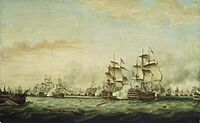
From April 9-12, 1782, Canada fought in the Battle of the Saintes. This was a major battle for the British fleet, led by Admiral George Rodney. Canada had 12 killed and 23 wounded.
This victory stopped the French and Spanish from invading Jamaica. After the battle, Cornwallis returned to England. His ship, Canada, was taken out of service in October 1782.
Peace and New Commands (1783-1791)
After the American Revolutionary War ended in 1783, the navy became smaller. Cornwallis still had commands. He commanded HMS Ganges and then the royal yacht, HM Yacht Charlotte.
In 1788, he became a commodore. He was put in charge of the East Indies Station. This meant he commanded British naval forces in the East Indies.
Third Anglo-Mysore War
In 1791, while in the East Indies, Cornwallis ordered British ships to stop and search French ships. Even though Britain and France were not at war, the French were helping Tipu Sultan fight against the British.
A British ship, HMS Phoenix, stopped and searched a French frigate. The French were upset, but their government was too busy with problems at home to react much.
French Revolutionary Wars
After the conflict in the East Indies, the French Revolutionary Wars began. Cornwallis was promoted to rear-admiral in 1793.
Capture of Pondicherry (1793)
He helped capture Pondicherry, a French port. He commanded a small group of ships, including his new flagship, HMS Minerva. After this, he returned to England.
Leading the Channel Fleet
In 1794, Cornwallis was promoted to vice-admiral. He commanded different parts of the Channel Fleet. This fleet was very important. Its job was to stop France from invading Britain and to block French ports.
The Famous Retreat of Cornwallis (1795)
On June 16, 1795, Cornwallis was sailing near Brest with five ships. He saw a much larger French fleet of twelve ships. The French began to chase his slower ships.
Cornwallis made a bold move. He turned his small squadron around as if he had more ships coming to help. The French admiral thought Cornwallis had spotted more British forces. So, the French admiral ordered his ships to stop chasing. Cornwallis and his small fleet escaped safely. This event became known as "The Retreat of Cornwallis." It showed how much the French respected the British Navy.
Command of the Channel Fleet Continues
Cornwallis was promoted to Admiral in 1799. He took command of the Channel Fleet when Admiral Jervis became ill. He continued to lead the fleet from 1801 to 1804. His main job was to protect the British coast from Napoleon's planned invasion.
After Admiral Nelson's great victory at Trafalgar in 1805, Cornwallis left his command.
Honors and Political Life
Cornwallis received many honors. In 1815, he was made a Knight Grand Cross of the Order of the Bath.
His most special honors were his nicknames from the sailors: "Billy Blue," "Coachee," "Billy go tight," and "Mr Whip." Sailors only gave nicknames to commanders they truly liked. These names show that his men felt great affection for him.
Cornwallis also served as a Member of Parliament (MP). He represented the area of Eye for several periods between 1768 and 1807. He was also an MP for Portsmouth from 1782 to 1790.
Later Life and Legacy
William Cornwallis never married. In 1800, he bought the Newlands estate in Milford on Sea in Hampshire. His close friend, Captain John Whitby, and his wife, Mary Anna Theresa Whitby, lived with him.
After John Whitby died in 1806, Mary and her young daughter, Theresa, stayed and cared for Cornwallis in his old age. When Sir William Cornwallis passed away in 1819, Mary Whitby and her daughter inherited his fortune.


